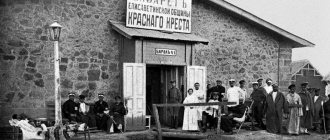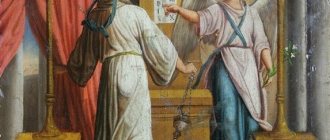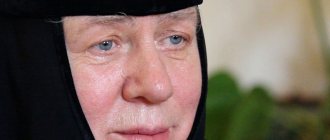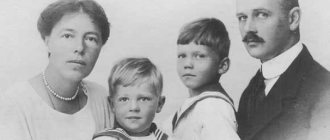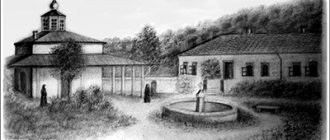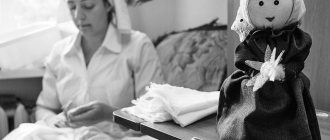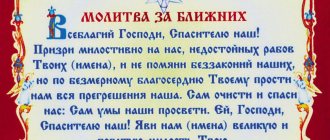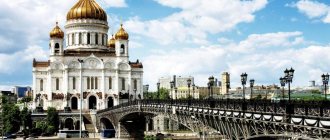ELIZABETHIN SISTERS
Abbess Elisaveta (Pozdnyakova), abbess of the Martha and Mary Convent of Mercy: “The patients of our rehabilitation center give us more than we are able to give them.”
Founded by Grand Duchess Elisaveta Feodorovna, the Martha and Mary Convent of Mercy is a special place in our city that still preserves the memory of the holy royal passion-bearers.
On the eve of the Royal Days, when the entire Church, the entire Russian people prayerfully honors the memory of the innocently murdered August family, we talk with the abbess of the monastery, Abbess Elisaveta (Pozdnyakova) about the continuity of the traditions laid down by St. prmts. Elisaveta Feodorovna. Abbess Elisaveta (Pozdnyakova)
Relying on traditions, we keep up with the times
– Mother Elizabeth, what was the idea of creating the monastery? What, in modern language, was the concept laid down by the Grand Duchess at its founding? – Elisaveta Feodorovna wanted to find a form of service in which the sisters could combine the monastic way of life, including divine services, prayer rules, with service to their neighbors. She believed that nuns should not go out into the world and engage in social activities. This service was performed by sisters of mercy who lived in the Monastery according to the rules of the cenobitic monastery, and tonsure into monasticism was the second step for sisters who wanted intensified feats of prayer.
Marfo-Mariinskaya Convent of Mercy
– Last May, the Holy Synod awarded the Marfo-Mariinsky Convent the status of a stauropegial convent. Has anything changed? – Nothing has changed fundamentally. We have two categories of sisters left: monastics and sisters of mercy. The latter today fulfill the ministry begun by Grand Duchess Elizabeth Feodorovna. This is the main tradition that is preserved in the monastery.
– Have innovations affected social services? — Elisaveta Feodorovna (this is evident from everything she did) was always guided by the necessity caused by time. Social activities are still a priority in the monastery today. Nevertheless, we do not try to copy everything that Elizaveta Fedorovna did. We are guided by what our reality says. After all, after a hundred years, our society has new needs and problems.
Three linden trees along Ordynka
– Is the charity festival “White Flower”, beloved by Muscovites, in its current format – your new endeavor? – This tradition was born in the depths of the royal family. It was she who initiated this holiday, which was first held in Moscow in 1911. The Russian aristocracy, starting with the emperor himself, made various crafts, postcards, and then held a charity bazaar that gained enormous popularity, where buyers received flowers for each item. This tradition then took root throughout Russia. Now, under the same name, the monastery hosts an annual charity festival, where funds are raised for one or another social project that currently needs support.
– Have all the buildings been preserved since the founding of the monastery? – Yes, they have all been preserved, although, of course, they have undergone serious restoration. Under the Grand Duchess, the Marfo-Mariinsky Convent also had buildings outside it, where social services were partially located. Now almost all of those premises are privately owned. In Soviet times, a large residential building was built next to the cathedral, and now it slightly extends into the territory of the monastery.
- And the trees? – All the old trees on our territory have been growing since the founding of the monastery. Also on Bolshaya Ordynka, Grand Duchess Elisaveta Feodorovna planted about twenty linden trees. Now only three of them have survived...
On Bolshaya Ordynka you can see trees planted by Grand Duchess Elisaveta Feodorovna
An enamel cross in a buttonhole And a gray cloth jacket... What sad faces And how long ago it was. What beautiful faces and how hopelessly pale - the Heir, the Empress, the Four Grand Duchesses...
Georgy Ivanov
How to keep the peace
– Emperor Nicholas II took part in the life of the monastery and visited it. Do you have any memories of these events? – Only photographs and letters. The Grand Duchess was close to the emperor, constantly corresponded with him, talked not only about the current affairs of the monastery, but also shared the innermost impulses of her soul and described her inner state.
– Now both of them are saints of the Russian Church. But there were serious disagreements between them! For example, Elizaveta Fedorovna called the murder of Grigory Rasputin a “patriotic act”... - If they communicated closely, this does not mean complete agreement. Of course, they, like all people, had some differences of opinion. But the Grand Duchess did not want to bring discord into the family and tried to avoid conflict situations. This did not always work out. It was beneficial for some people to quarrel between Elisaveta Feodorovna and the Royal Family. Nicholas II and his family lived in St. Petersburg, Elisaveta Feodorovna and Sergei Alexandrovich lived in Moscow. Therefore, creating a myth, starting a rumor that would then reach the Royal Family and sow discord, was not so difficult. At the same time, the Emperor, as a worldly wise man, tried to stay in the middle and never gave free rein to his feelings.
– What does the experience of social service of Grand Duchess Elisaveta Feodorovna teach us? – Nowadays many people are engaged in social activities. Sometimes this activity overwhelms us so much that we forget about our main purpose. We forget that when we set out to do this, we wanted to serve God. This, it seems to me, is one of the most terrible misfortunes that can happen to a church person, and the most terrible temptation that awaits him along this path. It is important to understand that we should do all good deeds not for the sake of ourselves and our ambitions, but for the sake of saving our souls and saving the people whom we are trying to help to the best of our weak strength. The sick children who come to us are sick for a reason - the Lord allows their illness as a necessary medicine for those around them; and they turned out to be near us, probably because we need them. We can help them with something. But this is a tiny share compared to the enormous help they give us. Every suffering person is close to us for a reason, but for our salvation. If we forget about this and get carried away with business, then such church-social service will lose all meaning and will be no different from the work of any state social centers.
Anastasia Chernova
Information: 1. Elizaveta Feodorovna (at birth Elizaveta Alexandra Louise Alice of Hesse-Darmstadt, her family name was Ella, officially in Russia - Elisaveta Feodorovna) - Princess of Hesse-Darmstadt;
in marriage (to the Russian Grand Duke Sergei Alexandrovich) the great House of Romanov. Honorary member and Chairman of the Imperial Orthodox Palestine Society from 1905 to 1917. Founder of the Marfo-Mariinsky Convent in Moscow. Honorary member of the Imperial Kazan Theological Academy (the title was Supremely approved on June 6, 1913). Canonized as a saint in 1992.
Monastery feeling
“A monk, as a rule, cannot live without a monastery. There is such an indicator of monastic life - when a monk cannot leave the monastery. There are novices who come to the monastery with the desire to live. After some time, such a novice says: “Can I go home for a month, on vacation?” This means that she can easily live without a monastery. A monk, even if he comes somewhere, participates in some events, as soon as evening comes, he does not understand why he is here? He begins to toil, he urgently needs to go home - to the monastery.
My home was several monasteries. First I was in one monastery, then in another, and now I live here. But my home is always in the monastery. It's the same as if I got married and my family's house became my home. I’ve had this feeling since I was fifteen.”
Participation in the construction of temples
On February 10, 1909, the princess, who had been in mourning for 4 years and spent almost all her time in prayer, gathered 17 sisters to organize the construction of the temple. She took off her mourning attire and put on a monastic robe.
The first church was built and consecrated at the expense of Elizabeth Feodorovna on September 9, 1909. The official opening of the building was timed to coincide with the celebration of the Nativity of the Blessed Virgin Mary. Soon a second temple was built, which was designed by the architect A. Shchusev. The artist M. Nesterov painted the walls and ceiling in the new building.
Another Orthodox church, thanks to the efforts of the princess, was built in the city of Bari (Italy). The relics of St. Nicholas of Myra of Lycia are now kept within its walls.
What is love
“As I imagine what love is... this is when, first of all, before God, secondly, before people, you need to be the way God or the person who is next to you needs you. It seems to me that this is self-sacrifice, real life for the sake of one’s neighbor. It’s like a desire for reassurance for the other, so that everything is fine with him.
I don’t know how to say what love is... God is love, and being for a person the way he needs you is one of the visible manifestations of this love. And you can’t demand anything for this. Today you are needed - you are nearby, tomorrow you are not - and you move away. Love is seeing another from the bottom up.
Just good
“At first I was very afraid to tell my mother about it. I was afraid that she would scold my aunt. But then the desire to tell what happened to me won out. Mom was shocked by my story, but praised me for going to the temple. And I tell her: “Mom, it’s so easy - can I go tomorrow too?” - “Go.” She even gave me some sandwiches so that I wouldn’t go hungry. I told her that there were a lot of beggars there, and she also gave me some change from my wallet.
And I started going to church. I went every day during the summer holidays. And the most interesting thing is that until my fifteenth birthday I did not know that there are services in the temple that begin and end at some point. I thought that the service was going on around the clock... I just felt good there. I didn’t think about anything.”
Description of the icon
Now about what the icon of St. Elizabeth looks like. This shrine was made on zinc, like many similar icons created by artists at that time. The image of the abbess is made in soft pink, greenish and blue shades. The saint is depicted in full height. It stands on the shore of a reservoir, behind which low hills can be seen. The woman is wearing a red scarf on her head. The ground under her feet is painted the same color. The body of Saint Elizabeth (this can be seen in the photo of the icon in the article) is covered by a green mantle. Blue skies are depicted above Elizabeth's head.
There are no symbols of the abbot's power in the image, however, the prayerfully focused face of the great martyr and the restrained soft appearance show our gaze an unceasing prayerful appeal and intercession to the Lord and to his spiritual authority. Elizabeth depicted on the icon seems to be asking for protection from the Almighty for those who pray to her for help.
The martyr’s right arm is bent and pressed to her chest in the area of her heart. This symbolizes that all her love is directed towards God and people. In the saint's left hand there is a scroll with a prayer for all those asking for blessings before her. Grand Duchess Elizabeth depicted on the icon asks the Almighty for forgiveness of human sins and peace after the souls of the dead go to the Last Judgment.
The picturesque shrine has the following dimensions:
- height – 71.12 cm;
- width – 13.34 cm.
Official biography of the great martyr
The holy martyr Grand Duchess Elizaveta Feodorovna was born into the family of Ludwig IV. Her mother, Princess Alice, was the daughter of Queen Victoria of England. In total there were 7 children in the family. One of the daughters, whose name was Alexandra, upon reaching adulthood, became the Russian empress.
The daughters of Duke Ludwig IV were raised in the family according to ancient English traditions. The upbringing was carried out by the mother, who established a strict time schedule for the girls. Despite the high title of the head of the family, the family tried to live modestly; their food was the same as that of ordinary citizens of the country. Ludwig had no servants, and his daughters did all the housework. They cleaned the house, lit the fireplace, washed clothes, and cooked food. Saint Elizabeth later said that at home she was taught everything that an independent woman needs to know.
The girls' mother tried to raise her children on the basis of Christian commandments, putting love for others in their hearts, and taught them to help people in need. Elizaveta Feodorovna's parents gave away most of their property to charity. In addition, the mother often took her daughters to hospitals, shelters for homeless people, as well as to homes for the elderly and disabled. Women took huge bouquets of flowers there and distributed them to others.
Elizabeth's hobbies
The future great martyr adored nature from childhood. She had a gift for painting, which is why she spent all her free time at canvas and with a brush in her hands. Most often the girl painted flowers. She also loved listening to classical music. All the relatives and acquaintances who knew the future great martyr emphasized her religiosity and love for her neighbors. The girl tried in everything to be like Saint Elizabeth of Thuringia, in whose honor she bore her name.
Prayer to the Martyr and Celebration
The patroness of the Sisters of Charity department at the Nizhny Novgorod Medical Institute is Elisaveta. The Icon of the Great Saint provides gracious assistance to all believers in need.
The Great Saint is addressed with the following words:
Oh, holy venerable martyr Elizabeth, chosen from the line of the sovereign beauty of the Russian Church, who served well with her abundant love for God and mercy for her neighbors, who laid down her soul for faith in Christ our Lord, adorned with the crown of the glory of Christ and honored to be the bride of Christ!
You shone like a God-bearing star in the lands of Russia, the holy martyr Elizabeth, when you counted wealth and glory as dust, you gave up your life in the hand of God, so that you served Him with fasting and prayer, and you showed love and great mercy to the suffering.
Filled with grace, your venerable relics appeared, the holy venerable martyr Elizabeth, who wanted to save them from reproach and dishonor, pious people brought to the holy city of Jerusalem and buried them in the weight of Gethsemane on the Mount of Olives, to whom those who fall find relief, consolation and healing.
Likewise, heal us sinners with your prayer and illuminate the path of our life with the light of your virtues. Pray, O our mother, that the Lord may grant us the gift of healing our passions, that He may transform our infirmities into strength for salvation, that we may not perish in the abyss of the cares of life, but may we be able to escape eternal torment and be heirs to the Kingdom of Heaven with all the saints who have pleased God from all eternity .
O Grand Duchess Elizabeth, the women of Russia are our adornment and joy, accept the sighing of our hearts offered to you with love, and through your intercession to the Lord strengthen the spirit of right faith and piety in us, strengthen us in virtue and mercy, help us cross the cross of sorrows with patience and hope bear, in love and harmony preserve our holy temple, so that we may be worthy to hear the Lord in joy, with the Angels and all the saints to glorify the Father and the Son and the Holy Spirit, now and ever and unto ages of ages!
Below we see one of the images of the Grand Duchess - Elizabeth the Wonderworker - an icon of the Holy Martyr.
Where is the icon kept?
Many believers are interested in the question: “Where is the icon of St. Elizabeth kept?” Famous for most believers, the Church of the Holy Apostles Paul and Peter was not persecuted after the revolution in the first half of the 20th century and worked throughout the existence of the Soviet Union. Thanks to the efforts of church servants, many valuable shrines have been preserved in their original form to this day, including the icon of the martyr Elizabeth. In the 90s of the last century, the Ivanovo monastery was opened and consecrated; several Christian shrines from the Church of the Holy Apostles Paul and Peter were transported there. The famous icon of Elizabeth was also sent there.
After the collapse of the Soviet Union, one of the first to be restored and opened to parishioners was the Church of the Venerable Martyr Elizabeth Feodorovna. This joyful event happened in 1995. The icon of the same name was transported there. Not long ago, the icon of the martyr Elizabeth was restored and placed in the Cathedral of St. John the Baptist, which is located on the territory of the St. John the Baptist Monastery.
In the convent of John the Baptist, a temple was built in honor of St. Elizabeth the Wonderworker. Funds for the construction of the building were allocated according to the will of the late philanthropist Elizaveta Zubacheva-Makarova. The woman was named after the great martyr of the same name. Saint Philaret of Moscow blessed the opening of the church.
Turn
“It seems to me that the Lord just grabbed me by the scruff of the neck and moved me around,” Mother Elizabeth doesn’t think that the little story about the fourth trolleybus route can really be called a “turnaround.” This is the story.
“We were a completely non-church family. True, I was baptized at the age of nine, but I never saw a church service or was in church at all. In Samara before the revolution there were many churches, but in Soviet times there were only two left, and they were very far from us - but we were raised strictly, and without mom and dad we didn’t go anywhere, only to the yard, and then they looked at us from the window .
When I was 11 years old, this happened to me. My aunt was staying with us, and when she had to leave, she asked me to accompany her to help her carry her bags. Apparently, my aunt had absolutely no idea that I had never in my life traveled far from my home alone. We are going with her to the very center of the city, somewhere very far away, to the station, I help her carry her bags, she leaves - I stay. I have twenty kopecks in my pocket, and I don’t know where to go, how to get home.
I looked around me and saw a temple. And I had this fixed idea - I really wanted to get to the temple! Even when I was baptized, in the baptismal near the temple, when we were already leaving, without even looking into the temple itself, I saw from a great distance that there was something very beautiful in the temple. And then I saw the temple and thought: “this is what I need.” I go to the temple. It's so good there! I bought candles for 20 kopecks and placed them at the icon of the Savior, prayed for my grandmother, who was very ill, was bedridden, and the whole family took care of her. Apparently, someone explained to me that I needed to pray for her.
I was very happy in the temple. And when I left there, I saw the 4th trolleybus passing by the gate. And I understand that this is my trolleybus, that it is the one that goes to my house. I ran after him for a whole stop, caught up, sat down without a penny in my pocket, and he took me home. And how did I know that he would get to my house? He could have gone in a completely different direction?”
Victim
“Until I was fifteen, I studied in a theater studio. She loved the theater with all her heart. I remember my role was Aunt Natasha’s wardrobe attendant in “The Tale of Lost Time.” Of course, I dreamed of becoming a director. It was a big tragedy for me to leave the theater.
In our house it was customary to read aloud. Mom would sit down and start reading something that interested her. What she read was not always interesting to me. One day she began to read John of Kronstadt, “My Life in Christ.” It wasn’t very interesting to me, but I listened because I understood that it was somehow pious. And so I hear: “The church is the house of God, and the theater is the house of the devil.” This was probably the first big tragedy in my life, but I decided that I was leaving the theater after all.
And then, in 1993, I found out that on Easter, a Satanist killed three monks in Optina Hermitage. It shocked me. “Wow, there must be something like that in monasticism...” I thought.”
First step
“I started reading a lot about the lives of saints. My favorite was Simeon the Stylite. I slowly began to somehow improve my spiritual life. Pray morning and evening. And one day I realized that it was time to take a decisive step, to leave everything and go to a monastery, as the saints did.
At that time, the Iversky Monastery had just opened in Samara. I’m riding a trolleybus, I see him, I get off at the stop, I enter the monastery, I go up to some grandmothers and say: “Take me.” They sent me to my father. It’s strange, for some reason he did not doubt that at the age of 14 it was quite possible to go to a monastery. He just said that I should not go to the Samara monastery, but somewhere further away, “because in Samara your parents will come to you - there will be no monastic life.”
Miracles
“After 9th grade, I didn’t understand what to do next. I will no longer be a criminologist or a director, as I wanted to do as a child. And who will I be? Mom then wanted, after successfully passing the exams, to give me a gift - to send me to the village. I've never been there and really wanted to.
And then she comes home from work and says: “Look what I found...”. Brings a newspaper. Then an Orthodox newspaper began to be published in Samara. And there, on such a huge spread, is information about the Holy Trinity Church, about a hundred kilometers from the city. Miraculous icon “Deliverer from troubles”, source, various miracles are described. It was a discovery for me that miracles happen. The advertisement said “we invite you to a pilgrimage.” I went and... didn’t come back.”
Elizabeth's Great Gift
Many people who believe in God are interested in the meaning of the icon of St. Elizabeth and what her help to people was. Almost 20 years ago, the scholar-historian A. Vinogradov translated the life of St. Elizabeth from Greek into Russian. After this, the St. John the Baptist Monastery published a printed edition of this text in 2002. According to the published book, Elizabeth the Wonderworker is the patroness of female monasticism. During her lifetime, she knew how to heal people from many diseases and ailments. The woman was a vessel of the Holy Spirit, from which grace flows, helping to give goodness and healing from torment. Even now, according to the clergy, kissing the icon of St. Elizabeth helps people get rid of many diseases.
It is written in the Life that the daughter, given to her parents by God himself, knew how to help believers burdened with grief and torment from illness. Even before conception, the parents came up with the name Elizabeth for the future saint. At a young age, the girl received the status of abbess at the monastery of St. George, which was built in Constantinople. Before her, the place of abbess there was occupied by her paternal aunt. The great martyr became abbess thanks to Saint Gennady, who at that time was the Patriarch of Constantinople.
Many believers are wondering: how does the icon of Elizabeth help people? Thanks to the woman’s humility, her sincere faith and monastic life according to the strict commandments of God, she acquired the gift of healing from an early age. The girl coped with the most terrible diseases that tormented the people around her, she also knew how to cast out demons, saw revelations and predicted the future. By venerating the holy icon in the church now, the sufferer will be freed from torment and will find peace of mind.
